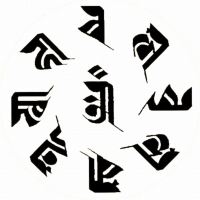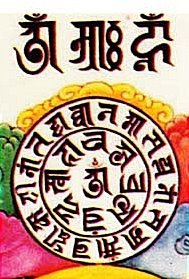Mystery Mantra
 A couple of days ago I noticed a mystery mantra on Omniglot's Puzzles Page. I couldn't see well enough to read so wrote and asked Mitchell who'd posted it to send a better quality image. He sent me the image on the left and things became more clear.
A couple of days ago I noticed a mystery mantra on Omniglot's Puzzles Page. I couldn't see well enough to read so wrote and asked Mitchell who'd posted it to send a better quality image. He sent me the image on the left and things became more clear.The script is obviously Lantsa. I know some Lantsa and there are one or two Lantsa resources on the web (see the scripts page) but I'm not very confident in it yet.
The centre syllable is obviously oṃ. From 12 o'clock I read ba la bra le bo nde svā hā.
So the mantra is: oṃ bale brale bonde svāhā.
Now in this script as in other Indic scripts the ba and va look very similar and so we could read oṃ vale vrale vonde svāhā. They are similar enough to suggest that they are all ba or all va. Otherwise I'm fairly confident of the reading. However this is not a mantra I am familiar with, nor can I find it in any of my usual sources. If you know this mantra please let me know.
Update: 18-9-08 and 3-11-08

Thanks to Fuxi who wrote in to suggest that this mantra may be related to Zhunti. If you look at Mediation Expert you can see the same diagram on a page of the sadhana instruction. In Sanskrit the name is Cundī, meaning "pure" and she is a feminine form of Avalokiteśvara, or perhaps a form of Uṣas or Mārīcī. In the Mahācundi Dhāraṇī there is a mantra: namo saptanam samyaksambuddha kotinam tadyatha: om, cale, cule, cundi svaha. The mantra above could be a form of this.
If you look at the image on the left, which is a close-up of a Cundi image, you can see some Sinified Lantsa script.
Across the top in larger letters is: oṃ āḥ hūṃ
Around the outer circle of the image reads: namo saptanam samyaksambuddha kotinam tadyatha. It starts just to the right of 12 o'clock.
The centre of the circle matches the image originally sent to Omniglot by Mitchell, with oṃ at the very centre. Ca is distinguished by a point on the loop - so with some hindsight we can see that the character could be ca. On the 3rd character what I took to be an 'r' ligature could be a 'u' diacritic though this usually is more curved and doesn't terminate on the stem. So the mantra above should be read:
oṃ cale cule cunde svāhā.





